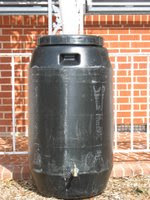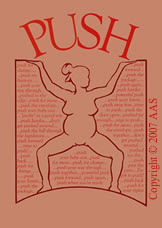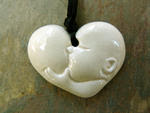"The neonatal death rate for Caesarean birth among low-risk women was 1.77 deaths per 1,000 live births. The comparable rate among vaginal births was 0.62.
Babies are up to three times more likely to die soon after delivery if their mothers choose a Caesarean section rather than a normal birth, a big American study has shown."
http://answers.google.com/answers/threadview?id=480523
It is one thing to be in shock (or not) over the high rate of death during planned cesarean birth -- it's a national shame to have allowed surgical births to rise from 22.6% in 1999 to 30% in 2005 (Center for Disease Control http://www.cdc.gov). It is criminal to promote and allow non-medically necessary, planned cesarean births, knowing that surgery is inherently dangerous to a woman and a baby. WHO is actually planning these surgeries, women or obstetricians?
How much higher is the death rate now and how many babies have needlessly died? And more than
 that! What about the survivors? We still are not addressing the quality of life in birth and the impact of surgical birth on the SURVIVOR's emotional, physical, and spiritual life.
that! What about the survivors? We still are not addressing the quality of life in birth and the impact of surgical birth on the SURVIVOR's emotional, physical, and spiritual life.Unbridled freedom to do what is not shown safe is allowed in obstetrical medicine under the guise of safety. Meanwhile, evidence-based science shows us inducing, epidural, supine position, rupturing membranes, fetal monitoring all lead to cesarean birth, and yet these practices continue. Why is the fox in charge of the hen house?
What accounts for and justifies this ongoing practice that is so harmful to women and children and more life-threatening than vaginal birth? What is the IMPACT OF SURGICAL BIRTH ON THE SURVIVORS?
This seems relevant to the discussion homebirth and hospital safety; however, I have not seen this "debated" on www.homebirthdebate.blogspot.com.
On that blog the author steadfastly maintains this bottom line, "There is NO SCIENTIFIC EVIDENCE that shows homebirth to be as safe as hospital birth." (Even though she also posts that the current data shows a very insignificant increase in neonatal deaths in homebirth. Check an earlier post here about homebirth in MO). How is hospital birth with a 30% cesarean rate where mortality is 3 times higher than vaginal birth safer? And, meanwhile there is plenty of research to show that hospital birth is NOT SAFE and that the unconscious* misuse of technology and interventions leave lifelong consequences.
It seems to me that it is more important to debate the SAFETY of HOSPITALS since that is where 98+% of births take place and because of the high infant mortality rate in US hospitals. We need to be questioning the use of many interventions and drugs, but in particular, we need to be addressing the 20% of the unnecessary cesarean births (the difference between established expected rate of necessary surgical birth and current rate) rather than 1% of births at home where risk is not even statistically significant compared to hospital birth. Furthermore, this is not even looking at the death rates of babies who were born by necessary cesareans.
Baby is three times more likely to die in planned cesarean than in a vaginal birth -- and, those are JUST the fatalities?! "Dead babies", as Dr. Amy so warmly calls them. Three times more likely to die from surgical birth than a vaginal birth. Please consider THAT'S JUST the DEATH rate for planned cesearean. Fact is that LIFE is in degrees, not bi-polar black or white, dead or alive. Babies born by cesarean are not either dead or alive (as in "fine").
Something so inherently dangerous as surgery (and war) tells us that besides the dead, there are many casualties. We Americans, most born "under the influence" of drugs are the walking numb -- drugged from birth to disregard the truth and real pain. For example, our media speaks of the low mortality rate in Irag now in order to calm us about how little we are sacrificing. Today, December 6th the mortality count is at 2903 with seventeen pending. However, there are 46,880 non-mortal casualties. While the death of our young people is tragic -- it's almost more tragic that so many are seriously wounded and face a lifetime of familial, financial, physical, emotional, and mental struggles as a result. (Source: http://icasualties.org/oif/). It's exactly the same belief system about how we birth our babies. A smaller number die now, but the means to getting there (drugs, disruptions, violations, trauma, time restraints, money vs human needs) are creating a world of confused warriors in a "Christian, peaceful, and compassionate society". Our obstetric health care system is creating dysfunction, pathology, and warriors.
Well, the United States is not the "Wild West" anymore and we have the best and most accessible medical care in the world. We are not about "dead or alive" as the measurement. We can not simply just look at any situation (ie, like health, birth and war) dealing with human life in terms of "dead or alive" as the measurement or reason for justifying what we are doing. We in the US are an educated, sophisticated, affluent, compassionate, and peaceful nation (George says so). We are a democracy and we believe in equality and quality that is based on freedom, liberty, and responsibility. We are about having and maintaining a "Quality of Life."
Dead or alive, good or bad, pass or fail -- these are not the scales for measuring quality of life and our social and individual lives and accomplishments! Alive or dead is never the best assessment of the total individual and for assessing quality, or longevity. Who wants an aeuronatics or bridge engineer, or a cardiologist or neurosurgeon who just "passed", maybe with a "D" or a "C'? I am sure like me, you want your doctor to have shown his or her ability and quality -- with a A, maybe a B. Medical students who will sacrifice, manipulate, fight, lie, pout, and steal to get the top grades are now willing to be physicians who are satisfied with merely an "alive baby" (or cardiac patient) as the measurement of their success? Physicians, whose entire lives have been quality oriented are ok with just a "live baby"? THAT's a big problem.
C 'mon, Dr. Amy, you disgrace your profession. Or, is this just your opinion or your "painted-yourself-in-the-corner, spinach-in-your-teeth, caught-with-your- pants-down" egotistical defense. Dr. Amy, Prez, just admit it -- you're not perfect. IT's okaaaaay. So, can we all just change course now, and save the QUALITY of lives of our babies?
So, why in obstetrics, in accessing the quality and health status of a newborn human being, is an "alive baby" satisfactory?? Come on, all of you physicians who care for babies and women --- we need quality expectations in birthing our babies. If it's truly liability that makes you practice this way, do something about it. For the babies. We need quality protocols in assessing the outcomes of the birth experience -- the most important experience of the human being's life.
So, what about those "alive babies" and the quality of their birth, health, and future lives?? It is logical and scientific that statistically speaking, that a very high high percentage of the "live babies" of necessary and planned cesarean are likely very seriously injured as well. They are somewhere along the continuum of critical condition to fair to good condition. These babies born by cesarean who "pass" "alive" and "seem fine" but are injured or now stuck with life long health prob
 lems are profoundly disregarded. The bruising of this baby was not even "mentioned" by medical staff. "See no evil, hear no evil, speak no evil."
lems are profoundly disregarded. The bruising of this baby was not even "mentioned" by medical staff. "See no evil, hear no evil, speak no evil."Where on the continuum of dead and alive, good and bad, does this human baby with horribly bruised face fall? IRONICALLY, THANKFULLY, she was not a medically necessary cesarean, but one of the twenty percent who was a healthy, no-risk baby who was induced (known to lead to surgical birth) so she physiologically endured induced, drugged labor and surgery without the need of life support afterward. I am not a doctor, but we all know the healthier one is the best one fares in surgery.
Twenty percent of the 30% c-section surgeries in this country are done to HEALTHY women and babies. This, however, is used to justify the mis-belief in obstetrics that surgery is safe -- because healthy babies survive it. But, WHAT is the cost to a healthy woman and baby who do NOT need an INHERENTLY DANGEROUS abdominal surgery -- repeatedly, if she wants more children? And what about the baby? Look at my sweet friend in the pictures. What about her emotional experience and the traumatic forces upon her face and brain and her health?
What is not being considered is the internal effects on hormonal and homeostasis, damage to heart, brain, and liver functioning, effects on lung and digestive functioning, and physical the trauma of having hips, limbs, and head pulled with terrible forces by surgeon. Healthy babies "appear" to endure this easier. Do they? Not according to William Emerson at www.emersonbirthrx.com, pioneer in the trauma healing of cesarean birth.
From "http://answers.google.com/answers/threadview?id=480523
The author provides an extensive listing of research indicating newborn, childhood, and life-long complications associated with cesarean birth.
So, the rest of the news story about the death rate of babies born by cesarean:
The team studied more than 5.7 million live births and nearly 12,000 infant deaths in the United States from 1998 to 2001. They counted deaths among babies that occurred within 28 days of birth, called neonatal deaths...
The American study is the first to compare death rates after elective surgeries, when women chose the procedure in advance in consultation with their obstetricians. The cases chosen were those of women with no known medical reason for the procedure, or with no special complications during labor."
The study:
Birth
Volume 33 Issue 3 Page 175 - September 2006
doi:10.1111/j.1523-536X.2006.00102.x
Infant and Neonatal Mortality for Primary Cesarean and Vaginal Births to Women with "No Indicated Risk," United States, 1998–2001 Birth Cohorts
Marian F. MacDorman, PhD1, Eugene Declercq, PhD2, Fay Menacker, DrPH, CPNP1, and Michael H. Malloy, MD, MS3
ABSTRACT:
Background: The percentage of United States' births delivered by cesarean section has increased rapidly in recent years, even for women considered to be at low risk for a cesarean section. The purpose of this paper is to examine infant and neonatal mortality risks associated with primary cesarean section compared with vaginal delivery for singleton full-term (37–41 weeks' gestation) women with no indicated medical risks or complications.
Methods: National linked birth and infant death data for the 1998–2001 birth cohorts (5,762,037 live births and 11,897 infant deaths) were analyzed to assess the risk of infant and neonatal mortality for women with no indicated risk by method of delivery and cause of death. Multivariable logistic regression was used to model neonatal survival probabilities as a function of delivery method, and sociodemographic and medical risk factors.
Results: Neonatal mortality rates were higher among infants delivered by cesarean section (1.77 per 1,000 live births) than for those delivered vaginally (0.62). The magnitude of this difference was reduced only moderately on statistical adjustment for demographic and medical factors, and when deaths due to congenital malformations and events with Apgar scores less than 4 were excluded. The cesarean/vaginal mortality differential was widespread, and not confined to a few causes of death.
Conclusions: Understanding the causes of these differentials is important, given the rapid growth in the number of primary cesareans without a reported medical indication.
(BIRTH 33:3 September 2006)
* Unconscious action relates to the societal disregard for the fact that the human newborn and laboring and birthing baby is a fully formed, feeling, engaged, interacting, imprinting human being who is physiologically designed and needs to participate with mother (father), the environment, and caretakers. NO ONE, doctor, mother, or baby ought to be "drug impaired" or "under the influence" of drugs. When acknowledged and spoken to with regard for their choices and needs, a laboring, birthing, or newborn baby will interact with, not resist in fear or opposition, a caring person who is conducting a life-saving or medically necessary intervention.








2 comments:
1.77 per 1,000 is "three times as likely", not "3X More Likely", than 0.62 per 1,000.
Thanks, Will.
Would you please elaborate? The languaging was from another person -- which I cited. I am sure others would like to know more specifically what this study tells us and I am sure each side as different understanding of the information. How is a pregnant woman to interpret this information and make her informed decisions?
Meanwhile, I am more interested in discussing the level of SAFETY and QUALITY OF HOSPITAL BIRTH and the experience of the baby who is born in the hospital.
And, I'd like to have research citings that show that inducing a baby's labor or using narcotics has no physiological or psychological impact in the short term or long-term.
Any research that shows narcotics were studied PRIOR to using in labor and birth? The BBB barrier of the newborn isn't developed for two weeks after birth - I am looking for that particular research paper from the University of Arizona. I wonder if nature intended for the mother's body to continue protecting the laboring and birthing baby and infant from toxins.
Thanks again.
Janel
Post a Comment